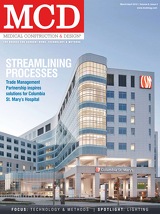Medical Construction & Design (MCD) is the industry's leading source for news and information and reaches all disciplines involved in the healthcare construction and design process. To view more past issues go to: http://mcdmag.epubxpress.com
Page 34 of 70
Creating accessibility,
fostering dignity for patients in urban centers
By Henry Meltzer Photos by Rene Perez
Breaking down BARRIERS
Those creating healthcare spaces focused on disabled populations have a duty to foster accessibility by removing typical physical and psy chological barriers in facilities. The ultimate design goal is to ease access to services catered to improving the health and wellness of the disabled populations in order to help them lead healthier and more productive lives.
Exterior entrance with new canopy and power- assisted entrance door.
Given the population concentration (and resources avail- able on the municipal, academic or private level), urban centers have several major healthcare institutions providing services to the disabled populations. While most big cities usually have a fair number of institutions offering services to the disabled, these institutions also face many challenges in physical space and accessibility. A competitive urban real estate market often requires these institutions to share space with other businesses or institu- tions with no special agenda for address- ing the needs of the disabled beyond the basic access guidelines. For a disabled person, however, ac-
cessing an institution in a shared building often means count- less physical and psychological barriers that ultimately make these institutions feel out of reach. Long elevator wait-times, the stigma of trying to fi t wheelchairs into crowded elevators and the general issues with little-used wheelchair access entry- and exit-ways, are a few of these. Consequently, the hassle of access outweighs the health and social benefi ts gained by attending the programs offered in these centers.
30 Medical Construction & Design | March/April 2012 Reception area and patient/visitor lounge are directly accessible at street level.
Simple solutions provide greater ease With the desire to fi nd a better way, design fi rms are working hard to generate solutions for these common problems for the disabled, and a few simple design ideas have emerged and are continuing to arise that will help make special-needs individuals a priority. For example, healthcare organizations serving the dis- abled can impact a larger number of people by providing greater ease and access through a standalone facility, which removes the diffi culties of shared access. A dedicated, street- level entrance may make all the difference when welcoming the disabled population and relieving them from the stress of entry and exit into a shared building. Furthermore, ease of access to the facility can be further achieved by building larger elevators that fi t several patients with wheelchairs. Entry, exit and elevator buttons can be placed lower and at arm's reach. Another solution is to add more automatic doors throughout the facility. These basic design solutions can mean huge changes in physical and emotional comfort and therefore welcome additional disabled
www.mcdmag.com
